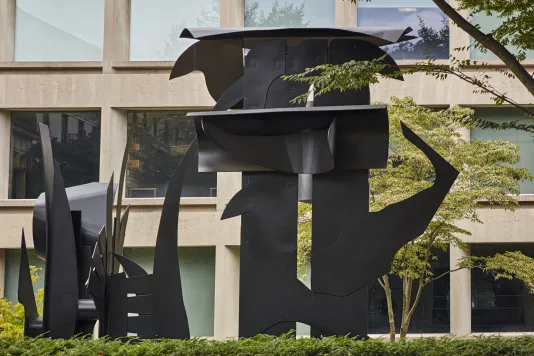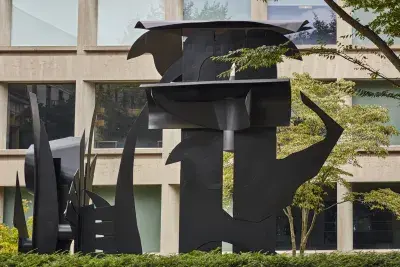Louise Nevelson, Transparent Horizon, 1975. Purchased with MIT Percent-for-Art funds. © 2025 Estate of Louise Nevelson / Artists Rights Society (ARS), New York. Photo: Charles Mayer Photography
Transparent Horizon, 1975

Louise Nevelson’s longstanding preoccupation with found objects and geometric wooden forms might be traced back to her childhood, when her father operated a lumberyard that doubled as her playground.
A scavenger’s delight and a builder’s logic are evident in her works of the 1950s, in which she arranged pieces of castoff wood collected on the streets of New York within boxes that she then painted—usually black or white—and stacked to form larger installations. Beginning in 1965, Nevelson explored materials such as transparent industrial plastics and enameled metal. Her organization of forms became more systematic, resulting in more open and less densely packed sculptures, and her choice of more durable materials led her to accept her first commission for an outdoor sculpture in 1969. During the following years, she was inspired to combine found elements with fabricated pieces in freestanding sculptures. Botanical imagery predominates in these welded metal works; their shapes, like their titles, suggest flowers, trees, gardens, and landscapes.
Transparent Horizon is from this phase of Nevelson’s development. Its open arrangement of components along an axis aligns the composition with her wall-like sculptures, while the combination of rigid and organic shapes recalls her tabletop landscapes of the 1940s, grounded in the Surrealist sculpture of Alberto Giacometti. The piece is an amalgam of two earlier painted aluminum sculptures (Nevelson often revised and transformed older works by melding them into new ones): Tropical Tree IV (1972) is reflected in the shorter portion of Transparent Horizon, with its flat frond-like projections from a trunk-like core, and Black Flower Series IV (1973) lends this piece its taller stems and spiky leaf-forms, capped by overlapping petal shapes. The resulting sculpture, an imaginative interpretation of nature surrounded here by actual trees, suggests a process of growth through stem- and flower-like forms, while also evoking a gate or passage to an otherworldly, spectral space.
Louise Nevelson (1899–1988) was born in Kiev, Russia (now Ukraine) and immigrated with her family to Rockland, Maine, in 1905. She moved to New York City in 1920 and took classes in painting and drawing at the Art Students League. A brief period of study in Munich with the painter Hans Hofmann firmly established the influence of Cubist design and collage. Also formative were Dada, Surrealism, as well as African art and Indigenous and pre-Columbian art of the Americas, in which she perceived a sense of magic and mystery. Nevelson exhibited her work in numerous solo and group shows at institutions including the High Museum of Art, Atlanta; Musée d’Art Moderne de la Ville de Paris; Moderna Museet, Stockholm; Art Institute of Chicago; Carnegie Museum of Art, Pittsburg; Brooklyn Museum; and Hara Museum, Tokyo, among many others. Her first major retrospective was held at the Whitney Museum of American Art in 1967. Her many honors and recognitions include the Gold Medal for Sculpture from the American Academy of the Arts (1983), a National Medal of Arts (1985), and the Solomon R. Guggenheim Museum’s Great Artist Series Award (1986). Louise Nevelson died in New York in 1988.
